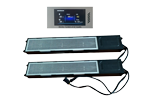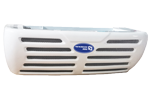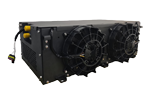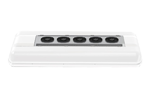The evaporator in the air conditioning refrigeration circuit is replaced with a heat exchanger, and then a water pump that drives the water circuit is installed to convert the air conditioning by the air conditioning to the cooling of the coolant, thereby achieving the effect of forced cooling. The system can intelligently control the power of the compressor, fan and water pump according to the input temperature and output temperature requirements of the coolant, adjust the cooling capacity of the system, and realize the control of the output water temperature.
1) System composition. The cooling system mainly includes electric compressors, condensers, fans, expansion valves, heat exchangers, water pumps, pipelines, controllers and wiring harnesses.
2) Working principle. When the cooling system is working, the electric compressor compresses the refrigerant (usually R134a) into a high-temperature liquid, flows through the condenser to dissipate heat, passes through the expansion valve, and becomes low-temperature and low-pressure wet steam, and then enters the refrigerant passage of the heat exchanger to absorb heat. So as to reduce the temperature of the heat exchanger, and finally return to the electric compressor for the next refrigeration cycle. At the same time, the water pump draws the cooling liquid through the liquid flow channel of the heat exchanger, and the low-temperature heat exchanger absorbs the heat in the cooling liquid, thereby achieving the effect of reducing the temperature of the cooling liquid.
3) Structural layout. Considering the layout space of the whole vehicle and the reliability and convenience of installation, the various components of the cooling system are integrated and designed inside a box to form a system component, and the high and low voltage interface and the external circuit are designed on the box. In and out of water. Its advantages are: high integration, strong versatility, can be applied to a variety of pure electric passenger car models, without changing the layout of the internal components of the system and the piping design according to different models; the layout and installation of the whole vehicle are simpler and easier Operation; convenient maintenance, easy troubleshooting, and lower after-sales cost.









.png)






